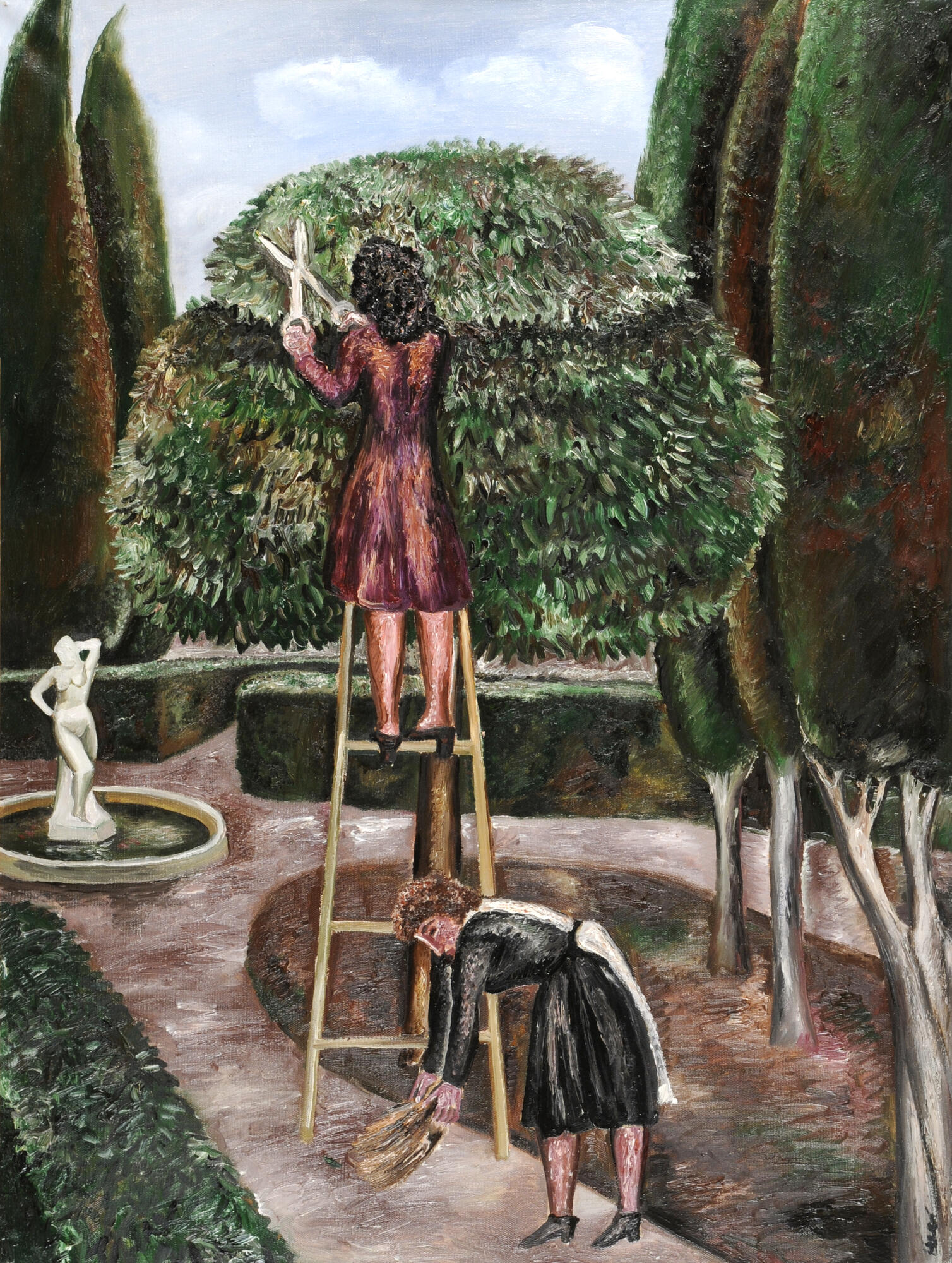The name and work of Natalia Nesterova have already become a certain hallmark of Russian painting from the seventies. The daughter of an architect who grew up in the very heart of the Old Arbat neighborhood, she absorbed the rich Moscow culture starting in her childhood. Trimming Trees. Zhukovka is one of the first
paintings that demonstrated the style that Nesterova developed. Before us is a nook in a seaside park in Crimea, which previously belonged to the estate of Yakov Zhukovskiy and was part of an architectural ensemble with a park that was created at the beginning of the century - a park intended for secluded walks, intimate oneness with nature. Natalia Nesterova portrayed it at a time when the former villa was already called the Krivorozhskiy Gornyak Resort, and was not a secluded and quiet place but rather designed for ‘organized recreation’ for vacationers.
In the painting’s foreground women are depicted who, for the sake of symmetry and tidiness in the park, are busily destroying the “excess” in nature. One of them, bent down awkwardly, is sweeping the path, and the second, perched on the ladder, trims the dense crown of the tree with huge garden shears. The women’s movements are clumsy. Like cloth dolls, they simulate actions rather awkwardly instead of habitually performing them. In her artwork, Nesterova frequently resorts to the method of fragmenting reality, she captures small frame whose edges ‘cut off’ certain objects, and sometimes the figures of people. In the painting from our collection, a group of women occupies the central place, and the crowns of cypress trees line the sides, as if the curtains frame the nook in the park that is depicted.
Natalia Nesterova’s creative style is unique. The artist’s paintings are immediately recognizable, no matter what expositions they take part in. The complex textured painting, almost sculpturally molded tresses in the hairdos, foliage ‘growing’ with bouncy, pasty strokes, the figurines of people created as if from dough, facial features that also seem to be ‘molded’, protruding noses, cheeks… All of this is present in the work that we have. In ‘Zhukovka’, the author does not even try to strictly adhere to the laws of anatomy when interpreting the female figures.
In most of Nesterova’s canvases, another feature in her brushwork is clearly manifested: everything in them seems to be “molded” from a homogeneous, organic mass, while sculptures and houses retain their “stoniness”. In the painting Trimming Trees. Zhukovka we also see that the park and female figures are sculpted. Different qualities for the mass are only denoted by color. Depicting on canvas “random” fragments from our lives with some detachment (as if we are seeing it for the first time, and from the outside looking in), the artist expresses something big and important about us and our world. And that is how “Zhukovka” depicts a simple, everyday scene in an old park. But the way it is interpreted makes us look at the picture more closely and thoughtfully.
paintings that demonstrated the style that Nesterova developed. Before us is a nook in a seaside park in Crimea, which previously belonged to the estate of Yakov Zhukovskiy and was part of an architectural ensemble with a park that was created at the beginning of the century - a park intended for secluded walks, intimate oneness with nature. Natalia Nesterova portrayed it at a time when the former villa was already called the Krivorozhskiy Gornyak Resort, and was not a secluded and quiet place but rather designed for ‘organized recreation’ for vacationers.
In the painting’s foreground women are depicted who, for the sake of symmetry and tidiness in the park, are busily destroying the “excess” in nature. One of them, bent down awkwardly, is sweeping the path, and the second, perched on the ladder, trims the dense crown of the tree with huge garden shears. The women’s movements are clumsy. Like cloth dolls, they simulate actions rather awkwardly instead of habitually performing them. In her artwork, Nesterova frequently resorts to the method of fragmenting reality, she captures small frame whose edges ‘cut off’ certain objects, and sometimes the figures of people. In the painting from our collection, a group of women occupies the central place, and the crowns of cypress trees line the sides, as if the curtains frame the nook in the park that is depicted.
Natalia Nesterova’s creative style is unique. The artist’s paintings are immediately recognizable, no matter what expositions they take part in. The complex textured painting, almost sculpturally molded tresses in the hairdos, foliage ‘growing’ with bouncy, pasty strokes, the figurines of people created as if from dough, facial features that also seem to be ‘molded’, protruding noses, cheeks… All of this is present in the work that we have. In ‘Zhukovka’, the author does not even try to strictly adhere to the laws of anatomy when interpreting the female figures.
In most of Nesterova’s canvases, another feature in her brushwork is clearly manifested: everything in them seems to be “molded” from a homogeneous, organic mass, while sculptures and houses retain their “stoniness”. In the painting Trimming Trees. Zhukovka we also see that the park and female figures are sculpted. Different qualities for the mass are only denoted by color. Depicting on canvas “random” fragments from our lives with some detachment (as if we are seeing it for the first time, and from the outside looking in), the artist expresses something big and important about us and our world. And that is how “Zhukovka” depicts a simple, everyday scene in an old park. But the way it is interpreted makes us look at the picture more closely and thoughtfully.





